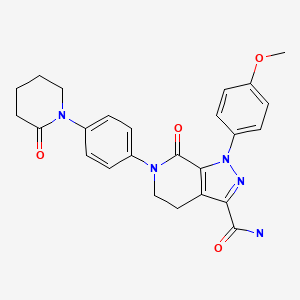Attribution Statement: LactMed is a registered trademark of the U.S. Department of Health and Human Services.
NCBI Bookshelf. A service of the National Library of Medicine, National Institutes of Health.
Drugs and Lactation Database (LactMed®) [Internet]. Bethesda (MD): National Institute of Child Health and Human Development; 2006-.
CASRN: 503612-47-3

Drug Levels and Effects
Summary of Use during Lactation
Information from four mothers indicates that apixaban levels in milk are rather high. An alternate drug is preferred, especially while nursing a newborn or preterm infant.[1-3]
Drug Levels
Maternal Levels. A nursing mother who was 23 months postpartum received 2 doses of 5 mg of oral apixaban 12 hours apart. Blood and milk samples were obtained before the first dose and at 3.5, 7, 12 (before the second dose), 16, and 24 hours after the first dose. Peak apixaban milk levels of about 230 mcg/L occurred at 3.5 to 4 hours after each dose. The average milk level over 24 hours was 113.6 mcg/L, which corresponds to a daily infant dosage of 17 mcg/kg daily and a relative infant dose of 12.8% of the maternal weight-adjusted dosage.[3]
Three lactating women were taking 5 mg of apixaban twice daily by mouth and were at steady-state. They extracted milk and provided samples at 0, 1, 2, 4, 6, 8, 10, and 12 hours after a dose. Peak milk levels of apixaban occurred at 1 hours after the dose in one woman and 2 hours after the dose in the others two. Peak levels ranged from 0.2 to 0.25 mg/L and average milk levels ranged from 0.134 to 0.16 mg/L. The absolute infant dosage was calculated to be 10 mcg/kg every 12 hours, which amounted to weight adjusted infant dosages of 14%, 20% and 21% in the three infants.[2]
Infant Levels. Relevant published information was not found as of the revision date.
Effects in Breastfed Infants
Relevant published information was not found as of the revision date.
Effects on Lactation and Breastmilk
Relevant published information was not found as of the revision date.
Alternate Drugs to Consider
Acenocoumarol, Dabigatran, Dalteparin, Enoxaparin, Heparin, Rivaroxaban, Warfarin
References
- 1.
- Daei M, Khalili H, Heidari Z. Direct oral anticoagulant safety during breastfeeding: A narrative review. Eur J Clin Pharmacol. 2021;77:1465–71. [PubMed: 33963877]
- 2.
- Datta P, Bramnik A, Rewers-Felkins K, et al. Transfer of apixaban into human milk. Obstet Gynecol. 2021;137:1080–2. [PubMed: 33957661]
- 3.
- Zhao Y, Arya R, Couchman L, et al. Are apixaban and rivaroxaban distributed into human breast milk to clinically relevant concentrations? Blood. 2020;136:1783–5. [PubMed: 32488251]
Substance Identification
Substance Name
Apixaban
CAS Registry Number
503612-47-3
Drug Class
Breast Feeding
Lactation
Milk, Human
Anticoagulants
Antithrombins
Disclaimer: Information presented in this database is not meant as a substitute for professional judgment. You should consult your healthcare provider for breastfeeding advice related to your particular situation. The U.S. government does not warrant or assume any liability or responsibility for the accuracy or completeness of the information on this Site.
- User and Medical Advice Disclaimer
- Drugs and Lactation Database (LactMed) - Record Format
- LactMed - Database Creation and Peer Review Process
- Fact Sheet. Drugs and Lactation Database (LactMed)
- Drugs and Lactation Database (LactMed) - Glossary
- LactMed Selected References
- Drugs and Lactation Database (LactMed) - About Dietary Supplements
- Breastfeeding Links
- PubChem SubstanceRelated PubChem Substances
- PubMedLinks to PubMed
- Discovery of 1-(4-methoxyphenyl)-7-oxo-6-(4-(2-oxopiperidin-1-yl)phenyl)-4,5,6,7-tetrahydro-1H-pyrazolo[3,4-c]pyridine-3-carboxamide (apixaban, BMS-562247), a highly potent, selective, efficacious, and orally bioavailable inhibitor of blood coagulation factor Xa.[J Med Chem. 2007]Discovery of 1-(4-methoxyphenyl)-7-oxo-6-(4-(2-oxopiperidin-1-yl)phenyl)-4,5,6,7-tetrahydro-1H-pyrazolo[3,4-c]pyridine-3-carboxamide (apixaban, BMS-562247), a highly potent, selective, efficacious, and orally bioavailable inhibitor of blood coagulation factor Xa.Pinto DJ, Orwat MJ, Koch S, Rossi KA, Alexander RS, Smallwood A, Wong PC, Rendina AR, Luettgen JM, Knabb RM, et al. J Med Chem. 2007 Nov 1; 50(22):5339-56. Epub 2007 Oct 3.
- Review Preclinical discovery of apixaban, a direct and orally bioavailable factor Xa inhibitor.[J Thromb Thrombolysis. 2011]Review Preclinical discovery of apixaban, a direct and orally bioavailable factor Xa inhibitor.Wong PC, Pinto DJ, Zhang D. J Thromb Thrombolysis. 2011 May; 31(4):478-92.
- Characterization of efflux transporters involved in distribution and disposition of apixaban.[Drug Metab Dispos. 2013]Characterization of efflux transporters involved in distribution and disposition of apixaban.Zhang D, He K, Herbst JJ, Kolb J, Shou W, Wang L, Balimane PV, Han YH, Gan J, Frost CE, et al. Drug Metab Dispos. 2013 Apr; 41(4):827-35. Epub 2013 Feb 4.
- Review Ubrogepant.[Drugs and Lactation Database (...]Review Ubrogepant.. Drugs and Lactation Database (LactMed®). 2006
- Review Atogepant.[Drugs and Lactation Database (...]Review Atogepant.. Drugs and Lactation Database (LactMed®). 2006
- Apixaban - Drugs and Lactation Database (LactMed®)Apixaban - Drugs and Lactation Database (LactMed®)
Your browsing activity is empty.
Activity recording is turned off.
See more...
